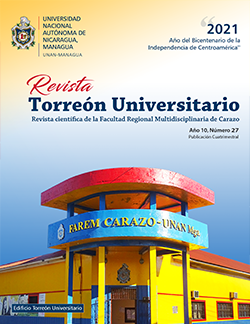Inventory of diurnal butterflies in tropical agroecosystems as bioindicators of environmental quality
DOI:
https://doi.org/10.5377/torreon.v10i27.10843Keywords:
Lepidoptera, ecosystem fragmentation, abundance, diversity, conservation, speciesAbstract
The research study was carried out at the Tiktik Kaanu Indigenous Community, specifically at the Agroforestry Transfer Center (CeTAF), with the objective of describing the taxonomic distribution of the diurnal Lepidoptera captured in relation to their different agroecosystems. As well as to make known, the wealth, abundance, and ecological functions of each taxonomic group. Through an exploratory and descriptive research, an inventory was made to identify the diversity of species existing in the site. The sampling reflected a total of 409 individuals with 41 species of butterflies belonging to 8 subfamilies. the most representative family and subfamily in number of species and abundances were Nymphalidae and Heliconae respectively, being the most abundant Heliconius Herato. Petiverana. There were significant differences in the richness and diversity of the research locations, existing a decrease as the landscape structure changes according to characteristics that influence the butterfly community. It is possible that the change of natural habitats into areas of agricultural use becomes a factor that modifies the structure of butterfly communities in the region. The inventory of diurnal butterflies in the CeTAF area is the first inventory of Lepidoptera that is carried out in the Caribbean area, which is within the Cerro Silva natural reserve in the Rama-Kriol territory that undoubtedly generates a base of important data for the region.
Downloads
Downloads
Published
How to Cite
Issue
Section
License
The authors who publish in this journal agree to the following terms.
- The author or authors of the articles, essays or research grant the National Autonomous University of Nicaragua, Managua (UNAN-Managua) the editing rights (copyright) of the submitted work, therefore the University has the exclusive right to publish the article for the entire copyright period.
- These copyrights/authors authorize Torreón Universitario Magazine and the University to edit and disseminate/publish the article in said Magazine, including printed and electronic reproduction, storage, retrieval and any other type of publication, and sources of secondary information as services. of summaries and databases, they also empower it to protect the article against unauthorized use for dissemination by printed or electronic media (PDF, HTML, EPUB, XML or others).
License for use of content
The magazine uses the Creative Commons Attribution-NonCommercial-NoDerivs 4.0 International License.
Under this statement:

This journal is licensed under a Creative Commons Attribution-NonCommercial-NoDerivatives 4.0 International License. It can be copied, distributed and transmitted publicly as long as the author and source are cited (Revista Torreón Universitario), it should not be modified or used for any commercial purpose. The full license can be found at http://creativecommons.org/licenses/by-nc-nd/4.0/.



